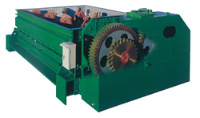Technical Information
Mixing
Mixer Unit


Uniform mixing done quickly. Also supports functional materials.
We continue to improve on our legendary two-shaft pug mill-type circulating-blending mixer with new ideas.
When material is brought to the top of the shaft, it comes directly into contact with added liquids like asphalt or softening agents. Below the shaft, the materials are stirred together for an even coating. We choose durable materials that can stand up to long hours of use, like abrasion-resistant cast iron liners, for the mixer liner, paddles, and tips.
In addition to asphalt mixing plants, our mixer can be used in any plant that requires a kneading machine, including batcher plants and soil improving plants. Tanaka Iron Works has developed plans for mixers suitable not only for asphalt but for a range of fields.
3D Mixer

Opening two mixer gates at the same time reduces scattering and makes release more efficient. Changes to the construction have made the already long-lived gate liner even more resistant to abrasion, increasing its lifespan further. The next advance in mixing, offering the same respected kneading performance as before.
Realizing Three Dreams
- Speedy Ejection
Shortening the release time helps prevent spillage from carriers. Gate release speed is 1.2 times faster than existing models (internal comparison).
- Less Spillage
Spillage of material from the sliding gates of earlier models has been reduced.
- More Durable
By keeping the highly praised oil bath the same and changing the gate construction, we were able to realize an advance in the abrasion resistance of mixer liners.
Oil Bath

Since the timing gear (mixer drive gear) is constantly moving, a constant supply of protective oil and anti-fouling agents is vital.
Submerging the gear in an oil bath ensures that it is always sufficiently lubricated, and since the oil bath cover is airtight, it is protected from fouling as well. This leads to better abrasion resistance and increased device lifespan.